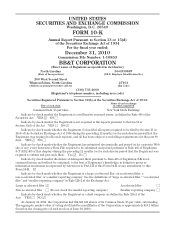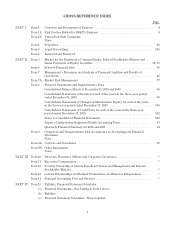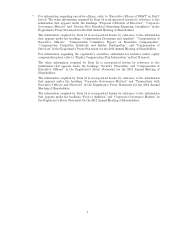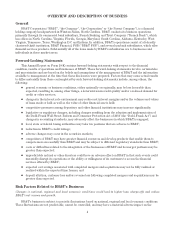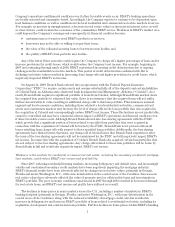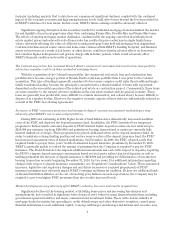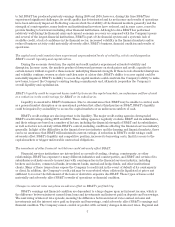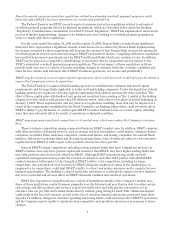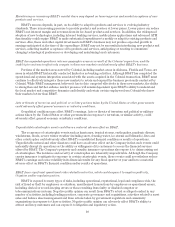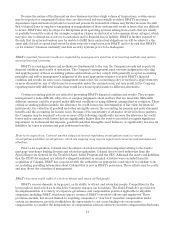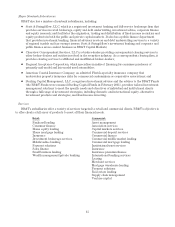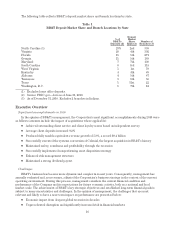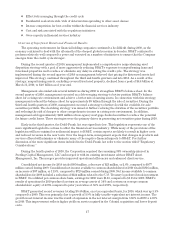BB&T 2010 Annual Report Download - page 9
Download and view the complete annual report
Please find page 9 of the 2010 BB&T annual report below. You can navigate through the pages in the report by either clicking on the pages listed below, or by using the keyword search tool below to find specific information within the annual report.Recently enacted consumer protection regulations related to automated overdraft payment programs could
adversely affect BB&T’s business operations, net income and profitability.
The Federal Reserve and FDIC recently enacted consumer protection regulations related to automated
overdraft payment programs offered by financial institutions, which are described below under the heading
“Regulatory Considerations—Automated Overdraft Payment Regulation.” BB&T has implemented, and is in the
process of further implementing, changes to its business practices relating to overdraft payment programs in
order to comply with these regulations.
For the years ended December 31, 2010 and December 31, 2009, Branch Bank’s overdraft and insufficient
funds fees have represented a significant amount of non-interest fees collected by Branch Bank. Implementing
the changes required by these regulations will decrease the amount of fees Branch Bank receives for automated
overdraft payment services and adversely impact BB&T’s non-interest income. Complying with these regulations
has resulted in increased operational costs for BB&T and Branch Bank, which may continue to rise. In addition,
BB&T may be placed at a competitive disadvantage to the extent that its competitors are not subject to the
FDIC’s automated overdraft payment program regulations. The actual impact of these regulations in future
periods could vary due to a variety of factors, including changes in customer behavior, economic conditions and
other factors, which could adversely affect BB&T’s business operations, net income and profitability.
BB&T may be subject to more stringent capital requirements which could diminish its ability to pay dividends or
require the Company to reduce its operations.
The Dodd-Frank Act requires federal banking agencies to establish more stringent risk-based capital
requirements and leverage limits applicable to banks and bank holding companies. Under the legislation, federal
banking agencies are required to develop capital requirements that address systemically risky activities. The
effect of these capital rules will disallow trust preferred securities from counting as Tier 1 capital at the holding
company level for entities with greater than $15 billion in assets, with a three-year phase-in period beginning on
January 1, 2013. These requirements, and any other new regulations, including those that may be imposed as a
result of the requirements established by the Basel Committee on Banking Supervision, could adversely affect
BB&T’s ability to pay dividends, or could require BB&T to reduce business levels or to raise capital, including
ways that may adversely affect its results of operations or financial condition.
BB&T may experience significant competition in its market area, which may reduce the Company’s customer
base.
There is intense competition among commercial banks in BB&T’s market area. In addition, BB&T competes
with other providers of financial services, such as savings and loan associations, credit unions, consumer finance
companies, securities firms, insurance companies, commercial finance and leasing companies, the mutual funds
industry, full-service brokerage firms and discount brokerage firms, some of which are subject to less extensive
regulations than BB&T is with respect to the products and services they provide.
Some of BB&T’s larger competitors, including certain national banks that have a significant presence in
BB&T’s market area, may have greater capital and resources than BB&T, may have higher lending limits and
may offer products and services not offered by BB&T. Although BB&T remains strong, stable and well
capitalized, management cannot predict the reaction of customers and other third parties with which BB&T
conducts business with respect to the strength of BB&T relative to its competitors, including its larger
competitors. Any potential adverse reactions to BB&T’s financial condition or status in the marketplace, as
compared to its competitors, could limit BB&T’s ability to attract and retain customers and to compete for new
business opportunities. The inability to attract and retain customers or to effectively compete for new business
may have a material and adverse effect on BB&T’s financial condition and results of operations.
BB&T also experiences competition from a variety of institutions outside of the Company’s market area.
Some of these institutions conduct business primarily over the Internet and may thus be able to realize certain
cost savings and offer products and services at more favorable rates and with greater convenience to the
customer who can pay bills and transfer funds directly without going through a bank. This “disintermediation”
could result in the loss of fee income, as well as the loss of customer deposits and income generated from those
deposits. In addition, changes in consumer spending and saving habits could adversely affect BB&T’s operations,
and the Company may be unable to timely develop competitive new products and services in response to these
changes.
9

